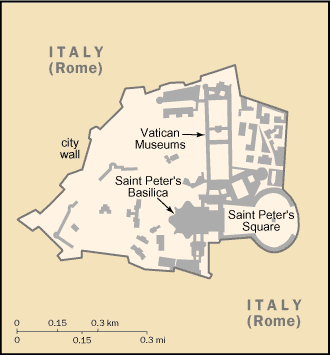Legend:
 Definition
Definition
 Field Listing
Field Listing
|
Background:
|


Popes in their secular role ruled portions of the Italian peninsula for more than a thousand years until the mid 19th century, when many of the Papal States were seized by the newly united Kingdom of Italy. In 1870, the pope's holdings were further circumscribed when Rome itself was annexed. Disputes between a series of "prisoner" popes and Italy were resolved in 1929 by three Lateran Treaties, which established the independent state of Vatican City and granted Roman Catholicism special status in Italy. In 1984, a concordat between the Holy See and Italy modified certain of the earlier treaty provisions, including the primacy of Roman Catholicism as the Italian state religion. Present concerns of the Holy See include the failing health of Pope John Paul II, interreligious dialogue and reconciliation, and the application of church doctrine in an era of rapid change and globalization. About 1 billion people worldwide profess the Catholic faith.
|
| |
People |
Holy See (Vatican City) |
|
|
Country name:
|


conventional long form: The Holy See (State of the Vatican City)
conventional short form: Holy See (Vatican City)
local short form: Santa Sede (Citta del Vaticano)
local long form: Santa Sede (Stato della Citta del Vaticano)
|
|
Government type:
|


ecclesiastical
|
|
Capital:
|


Vatican City
|
|
Administrative divisions:
|


none
|
|
Independence:
|


11 February 1929 (from Italy)
note: on 11 February 1929, three treaties were signed with Italy which, among other things, recognized the full sovereignty of the Vatican and established its territorial extent; however, the origin of the Papal States, which over the years have varied considerably in extent, may be traced back to the 8th century
|
|
National holiday:
|


Coronation Day of Pope JOHN PAUL II, 22 October (1978)
|
|
Constitution:
|


Apostolic Constitution of 1967 (effective 1 March 1968)
|
|
Legal system:
|


based on canon law and revisions to it
|
|
Suffrage:
|


limited to cardinals less than 80 years old
|
|
Executive branch:
|


chief of state: Pope JOHN PAUL II (since 16 October 1978)
head of government: Secretary of State Cardinal Angelo SODANO (since 2 December 1990)
cabinet: Pontifical Commission appointed by the pope
elections: pope elected for life by the College of Cardinals; election last held 16 October 1978 (next to be held after the death of the current pope); secretary of state appointed by the pope
election results: Karol WOJTYLA elected pope
|
|
Legislative branch:
|


unicameral Pontifical Commission
|
|
Judicial branch:
|


there are three tribunals responsible for civil and criminal matters within Vatican City; three other tribunals rule on issues pertaining to the Holy See
note: judicial duties were established by the Motu Proprio of Pius XII on 1 May 1946
|
|
Political parties and leaders:
|


none
|
|
Political pressure groups and leaders:
|


none (exclusive of influence exercised by church officers)
|
|
International organization participation:
|


CE (observer), IAEA, ICFTU, IOM (observer), ITU, NAM (guest), OAS (observer), OPCW, OSCE, UN (observer), UNCTAD, UNHCR, UPU, WHO (observer), WIPO, WToO (observer), WTrO (observer)
|
|
Diplomatic representation in the US:
|


chief of mission: Apostolic Nuncio Archbishop Gabriel MONTALVO
FAX: [1] (202) 337-4036
telephone: [1] (202) 333-7121
chancery: 3339 Massachusetts Avenue NW, Washington, DC 20008
|
|
Diplomatic representation from the US:
|


chief of mission: Ambassador R. James "Jim" NICHOLSON
embassy: Villa Domiziana, Via delle Terme Deciane 26, 00162 Rome
mailing address: PSC 59, Box F, APO AE 09624
telephone: [39] (06) 4674-3428
FAX: [39] (06) 5758346
|
|
Flag description:
|


two vertical bands of yellow (hoist side) and white with the crossed keys of Saint Peter and the papal miter centered in the white band
|
|
Economy - overview:
|


This unique, noncommercial economy is supported financially by contributions (known as Peter's Pence) from Roman Catholics throughout the world, the sale of postage stamps and tourist mementos, fees for admission to museums, and the sale of publications. The incomes and living standards of lay workers are comparable to, or somewhat better than, those of counterparts who work in the city of Rome.
|
|
Population below poverty line:
|


NA%
|
|
Household income or consumption by percentage share:
|


lowest 10%: NA%
highest 10%: NA%
|
|
Labor force:
|


NA
|
|
Labor force - by occupation:
|


agriculture NA%, industry NA%, services NA%; note - dignitaries, priests, nuns, guards, and 3,000 lay workers live outside the Vatican
|
|
Budget:
|


revenues: $209.6 million
expenditures: $198.5 million, including capital expenditures of $NA (1997)
|
|
Industries:
|


printing and production of a small amount of mosaics and staff uniforms; worldwide banking and financial activities
|
|
Electricity - production by source:
|


fossil fuel: NA%
hydro: NA%
nuclear: NA%
other: NA%
|
|
Electricity - consumption:
|


NA kWh
|
|
Electricity - imports:
|


NA kWh; note - electricity supplied by Italy
|
|
Economic aid - recipient:
|


none
|
|
Currency:
|


euro (EUR); Italian lira (ITL)
|
|
Currency code:
|


EUR; ITL
|
|
Exchange rates:
|


euros per US dollar - 1.1324 (January 2002), 1.1175 (2001), 1.0854 (2000), 0.9386 (1999); Vatican lire per US dollar - 2,099 (2000), 1817.2 (1999), 1,736.2 (1998), 1,703.1 (1997); note - the Vatican lira is at par with the Italian lira; the Vatican started using euros in 2002 in conjunction with Italy at a fixed rate of 1,936.17 lire per euro
|
|
Fiscal year:
|


calendar year
|
|
Disputes - international:
|


none
|
This page was last updated on 19 March 2003
|




